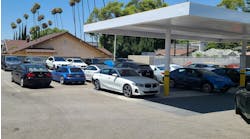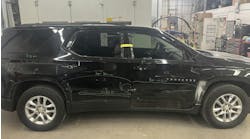Tire Rack study: Low rolling resistance tires net better fuel efficiency, reduced emissions
Recent testing by Tire Rack has confirmed that using low rolling resistance (LRR) tires “is an effective way for consumers to save money while reducing carbon emissions through increased fuel efficiency.”
The retailer has published comprehensive report analyzing LRR tires following an extensive evaluation at its South Bend, Ind. test track.
“As manufacturers continue to release more and more eco-friendly tire models, Tire Rack conducted a Real World Road Ride Economy Run to determine whether lower rolling resistance tires are effective at increasing fuel efficiency,” says John Rastetter, director of tire information.
The test, which used a small fleet of Toyota Prius hybrids outfitted with the Goodyear Integrity all season radial tires as a baseline, compared its fuel efficiency and traction to other eco-friendly and standard tire models. Each tire was driven over 550 miles of a 6.6-mile loop of expressways, highways and side roads. The Prius outfitted with the baseline tire achieved 51.4 miles per gallon.
Tire Line Test MPG* % vs. Baseline • Michelin Energy Saver A/S 53.8 +4.74% *Calculated based on GPS distances and ScanGage II recorded consumption (offset 6% for Prius Summer E10 regular grade fuel). |
Source: Tire Rack |
In the case of the Prius, the difference between the lowest and highest recorded miles per gallon would result in an annual difference of about 21 gallons of regular gasoline consumed at a cost of about $52.50 (at $2.50 per gal.) for drivers traveling 15,000 miles a year.
“Low rolling resistance tires represent the most environmentally-focused development in tire technology today,” Rastetter reports.
“Every gallon of gasoline saved not only reduces each driver’s personal fuel costs and America’s dependence on foreign oil, but it also releases 20 fewer pounds of CO2 gas into the atmosphere from the tailpipe. Our tests proved that vehicles equipped with these tires can achieve better fuel economy,” he says
“While the low-tech ways of achieving lower tire rolling resistance has usually traded off wet traction and/or treadwear,” Tire Rack’s controlled testing “has also shown that the newest high-tech, fuel-efficient tires have achieved it without compromising traction thanks to the introduction of new tread compounds, tire designs and weight optimizing manufacturing processes,” he notes.
According to newly passed governmental Corporate Average Fuel Economy (CAFE) standards, new vehicles will need to achieve 35.5 miles per gallon by 2016. “As automakers re-evaluate every aspect of their vehicles in order to increase fuel efficiency, fitting their vehicles with LRR tires is an easy first step,” Rastetter observes.
“While tires have always played an important role for all types of drivers, our test results show tire manufacturers have successfully added some green to the traditional round and black,” he adds.
The fuel economy recorded for each tire and its relative position compared to the Integrity’s average is available at www.tirerack.com/mpgtest.




